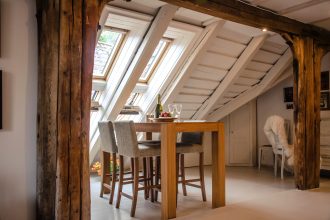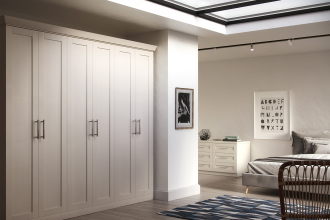Choosing quarry tiles for old and listed properties

Clay paving materials of various types have been a feature of British homes and gardens for centuries.
Often found in old and listed properties, quarry tiles in particular have been favoured for their naturally warm appearance, low-maintenance, durability and versatility, which has made them suitable for hallways, kitchens, living areas as well as, in more recent years, conservatories, patios and outdoor areas.
Timeless aesthetic appeal
In many ways the name ‘Quarry tile’ is a misnomer, as they are generally made from natural clay and shale, which has been processed, dried and fired – and not ‘quarried’ from solid slabs as the name might suggest. Cont’d/…
Originally made by hand, they had charming irregularities and came in a variety of natural fired earth colours – ranging from red, brindle and grey through to blue-black – depending on the characteristics of the local clay and temperature in the kiln when they were fired.
Then, with the advent of mechanization in the nineteenth century, pressed and extruded quarry tiles, known for their hardness and durability, were produced in volume and were often laid in utilitarian heavy-duty areas such as in kitchens, utility rooms and hallways.
With the Victorian penchant for ornate geometric floor designs, with black and red chequerboard, herringbone and octagonal shapes, quarry tiles soon became a classic decorative as well as a functional feature of 19th century homes, churches, schools and civic buildings.
Although, these elaborate designs eventually fell out of fashion and were often covered over in the 1980s and 90s, old quarry tile floors are now being rediscovered, lovingly restored and treasured by today’s homeowners.
Not surprisingly, since the demise of most of the small regional brickworks and tileries, the discontinued quarry tiles, once made by well-known manufacturers like Dennis Ruabon, Daniel Platt and Hawkins, are now much sought after in reclamation yards particularly by owners of old and listed properties, looking for genuinely sympathetic replacements for their restoration projects.
New Quarry tiles in listed properties
Although new quarry tiles are by no means in short supply on the market, finding genuinely authentic replacements with the aesthetic qualities of the traditional old English quarry tiles, which are suitable for listed properties, can be a minefield.
There are a number of key considerations before making any purchases. First and foremost, it is important to look beyond the marketing and not be swayed by ‘olde-worlde’ sounding names reminiscent of the tiles of the past, but to carefully examine their quality and any claims made in relation to their origin and suitability.
The sad fact is that most quarry tiles manufactured these days are neither English nor historically authentic. The majority are imported from abroad – mainly from Spain and Italy – most are not suitable for outdoor use and have an additional carbon footprint from the transport compared to a UK produced tile.
The original quarry tiles found in Victorian properties were traditionally made from dense English Etruria Marl clays, which produced robust and durable tiles. These were typically 18 mm thick, whereas many modern versions tend to be much thinner at 9-11mm and, when examined close up, have a uniform and smooth texture that is different from the traditional quarry tile.
Another important consideration is the colour quality of the quarry tiles. Genuine old English quarry tiles came in natural clay shades, with slight variations of tone and texture, which were produced solely through control of the atmosphere and temperature in the kiln. In modern tile making, this ancient technique has largely been lost with the passage of time, with most of today’s manufacturers now using a variety of stains and artificial pigments which have a duller, lifeless and more monotone quality.
Ketley Brick, which has made clay products on the same site in Staffordshire for 200 years using the same dense Etruria Marl clay, is the sole UK manufacturer of quarry tiles and they have retained these natural kiln firing processes. This natural aesthetic makes them an authentic replacement for Dennis Ruabon, Daniel Platt and Hawkins tiles.
Practical benefits and considerations
In addition to the importance of having a genuinely traditional appearance, there are a number of critical performance criteria to consider when choosing new quarry tiles.
Durability, low maintenance and good slip resistance are critical for any indoor or outdoor floor surface these days, whether it is in a modern or a listed property – particularly in areas where there is heavy footfall and constant wear and tear.
The durability of Victorian quarry tiles was once renowned. In order to achieve today’s performance standards, clay tiles are usually fired at temperatures of over 1150 degrees over a long duration. As these tiles are virtually vitrified or ‘glass like’, when they are fired at this temperature, they are highly durable and have a low water absorption rate. Those produced in the traditional way are usually frost resistant – unlike terracotta, which is fired at significantly lower temperatures and is porous.
To ensure optimum performance, it is advisable to choose quarry tiles that have less than 3% water absorption (which is one level below the ultimate low absorption rate of ‘impervious).
Modern standards also require various levels of slip resistance depending on where the quarry tiles are laid. However, for complete reassurance that the quarry tiles are safe in wet and potentially slippery conditions, they should comply with R11 and category C of BS EN 14411:2012, which is the highest rating for slip resistance in wet barefoot tests.
For complete confidence, it is advisable to check all performance certifications and C E marks, as well as the history and reputation of the manufacturer, so that you can rest assured that they are of high quality and, should there be any issues in the future, they can be easily resolved locally and with the minimum of inconvenience.
The Van Gogh’s London Home
A house in London, where Vincent van Gogh took lodgings as a young man in 1873, has been brought back to life using original materials and traditional techniques.
The Grade II listed Georgian terrace house at 87 Hackford Road, Stockwell, has been restored with great sensitivity by Cambridge University and Royal College of Arts graduate Livia Wang working with Andrew Shepherd Architects and Triskele Conservation.
Ketley’s Staffordshire red quarry tiles were laid in a kitchen extension and a new artist’s studio at the rear of the property to complement the house’s Victorian aesthetic.
Designer Livia Wang said: “It was important that these new additions complemented the house’s Victorian history and the original palette of clay, lime plaster and timber, and using Staffordshire clay quarry tiles was key to the design of the modern extensions.”
By Alex Patrick-Smith, Managing Director of Ketley Brick
For more information about Ketley’s range of quarry tiles call telephone: 01384 78361. Fax: 01384 74553. Email: sales@ketley-brick.co.uk or visit: www.ketley-brick.co.uk


